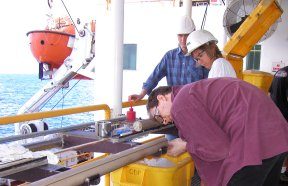Bugs with gas
Microbes living in sand under the sea may produce gases such as propane.
You may know of propane as the gas that fires up camp stoves or fuels outdoor grills.
Researchers have now found that microbes living under the ocean floor appear to produce propane and another gas called ethane. These microbes chew up ancient organic material, such as leaves and twigs buried in the sand, and they generate the gases as waste products.
That’s a surprise. Scientists had thought that propane and ethane could be produced only in the same way that petroleum is—by great heat applied to ancient, buried material.
 |
|
Kai-Uwe Hinrichs examines a sample taken from a cylinder of sediment drilled out of the ocean floor.
|
| Ocean Drilling Program Leg 201 Science Party |
A team led by Kai-Uwe Hinrichs of the University of Bremen in Germany went on a research ship equipped with an enormous drill that dug out cylinders of sand or rock thousands of feet long. When the researchers examined these cylinders, they found traces of ethane and propane locked in the sediment.
Normally, to generate these gases, Earth’s heat cooks organic material in sand for many thousands of years. This can happen only at spots above cracks in Earth’s crust, where heat can leak out from inside Earth, and where thick layers of sediment would act like a blanket.
But the samples that Hinrichs and his coworkers had looked at contained thin layers of sediment. Some cylinders had also been obtained from places far from any cracks in Earth’s crust. So where could the gases be coming from?
Scientists already knew that microbes could break down organic material to produce a related, simpler gas called methane. So, undersea microbes were the only thing that made sense.
“When you can’t come up with any geologic source, then biology is an obvious candidate,” Hinrichs says.
The finding may someday lead to practical applications. Propane is valuable as a fuel, and ethane is used to make plastics. Pulling propane and ethane out of sediment is too difficult to be practical. But if scientists can better understand how microbes create the gases, they might be able to use the microbes’ methods to make ethane and propane directly from organic material.
Going Deeper:
Rehmeyer, Julie. 2006. Gassy bugs: Microbes may produce propane under the sea. Science News 170(Sept. 30):213. Available at http://www.sciencenews.org/articles/20060930/fob4.asp .
You can learn more about propane at en.wikipedia.org/wiki/Propane and ethane at en.wikipedia.org/wiki/Ethane (Wikipedia).
Cutraro, Jennifer. 2006. Microbes at the gas pump. Science News for Kids (April 12). Available at http://www.sciencenewsforkids.org/articles/20060412/Feature1.asp .
Sohn, Emily. 2006. Plant gas. Science News for Kids (Jan. 18). Available at http://www.sciencenewsforkids.org/articles/20060118/Note2.asp .
______. 2004. Drilling deep for fuel. Science News for Kids (Sept. 29). Available at http://www.sciencenewsforkids.org/articles/20040929/Note3.asp .
ScienceFairZone
Harvesting Biogas from Manure







